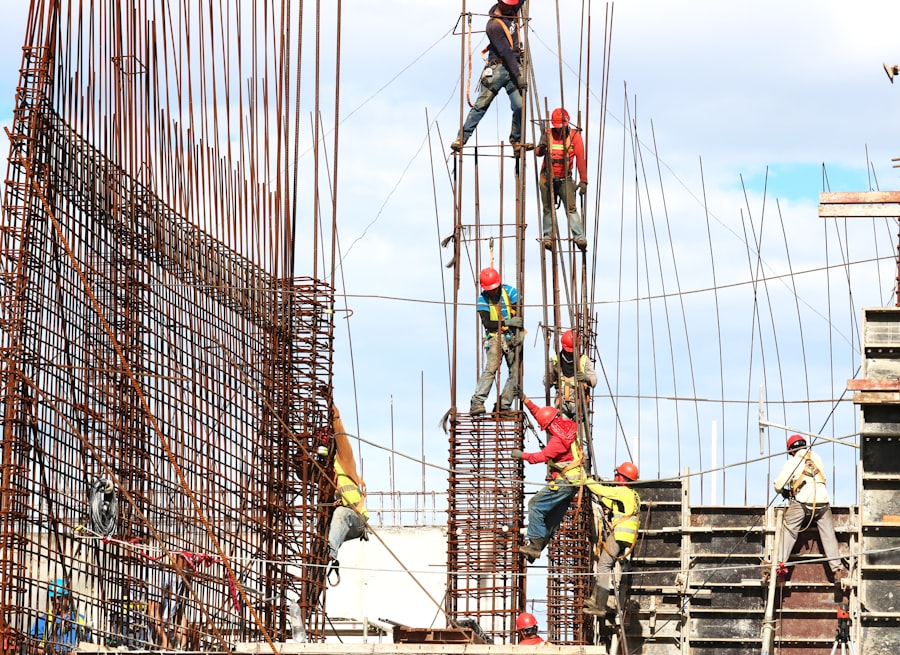Zoning and land use regulations are fundamental components of urban planning that dictate how land can be utilized within a given jurisdiction. These regulations are established by local governments to promote orderly development, protect public health and safety, and ensure that land use aligns with community goals. Zoning laws typically categorize land into various zones, such as residential, commercial, industrial, and agricultural, each with specific rules governing the types of activities permitted.
For instance, a residential zone may restrict the construction of commercial buildings, while a commercial zone may allow for a mix of retail and office spaces. Understanding these classifications is crucial for developers, as they must navigate the complexities of zoning ordinances to ensure compliance and avoid costly legal disputes. Moreover, zoning regulations often include stipulations regarding building height, setbacks, density, and parking requirements.
These parameters can significantly influence the design and feasibility of a project. For example, a developer planning to construct a high-rise apartment building in a low-density residential area may face significant hurdles due to height restrictions and community opposition. Additionally, land use regulations can evolve over time in response to changing demographics, economic conditions, and environmental considerations.
Therefore, staying informed about current zoning laws and potential amendments is essential for anyone involved in real estate development or urban planning.
Key Takeaways
- Zoning and land use regulations dictate how land can be used and developed, and it’s important to understand these regulations before starting any project.
- Conducting a comprehensive site analysis helps to understand the site’s opportunities and constraints, including environmental, social, and economic factors.
- Leveraging infrastructure and utilities can help maximize the efficiency and sustainability of a development project.
- Incorporating sustainable design and green building practices is essential for reducing environmental impact and long-term operational costs.
- Maximizing density and floor area ratio can help make efficient use of land and resources, but must be balanced with considerations for livability and community impact.
Conducting a Comprehensive Site Analysis
A comprehensive site analysis is an essential step in the development process that involves evaluating various factors that can impact a project’s success. This analysis typically includes an assessment of the physical characteristics of the site, such as topography, soil conditions, vegetation, and existing infrastructure. For instance, a site located on a steep slope may present challenges for construction and drainage, necessitating specialized engineering solutions.
Similarly, soil contamination or poor drainage can complicate development plans and require remediation efforts before construction can commence. In addition to physical attributes, a thorough site analysis should also consider the surrounding context, including land use patterns, transportation access, and proximity to amenities. Understanding the demographics of the area can provide insights into the needs and preferences of potential users or residents.
For example, a site located near public transportation hubs may be more attractive for residential development targeting young professionals who prioritize accessibility. Furthermore, analyzing local market trends can help developers identify opportunities for growth or potential challenges that may arise from oversaturation in certain sectors. By conducting a detailed site analysis, developers can make informed decisions that align with both regulatory requirements and market demands.
Leveraging Infrastructure and Utilities

Infrastructure and utilities play a pivotal role in shaping the viability of a development project. Access to essential services such as water, electricity, sewage systems, and transportation networks is critical for any new construction. Developers must assess the existing infrastructure to determine whether it can support their proposed project or if upgrades are necessary.
For instance, a large-scale residential development may require significant enhancements to water supply systems or road networks to accommodate increased demand. Engaging with local utility providers early in the planning process can help identify potential challenges and streamline the approval process. Moreover, proximity to transportation infrastructure—such as highways, public transit systems, and airports—can significantly influence a project’s success.
Developments situated near major transportation corridors often experience higher demand due to their accessibility. For example, mixed-use developments that integrate residential units with retail spaces near transit stations can attract residents who value convenience and connectivity. Additionally, understanding the capacity of existing infrastructure can inform decisions about project scale and design.
If a site is located in an area with limited road access or outdated utilities, developers may need to consider alternative solutions or adjust their plans accordingly to ensure long-term sustainability.
Incorporating Sustainable Design and Green Building Practices
| Metrics | Data |
|---|---|
| LEED Certification Level | Platinum |
| Energy Efficiency Rating | 90% |
| Water Conservation | 30% reduction |
| Recycled Materials Used | 50% |
Incorporating sustainable design principles and green building practices has become increasingly important in contemporary development projects. As awareness of environmental issues grows, developers are recognizing the benefits of creating spaces that minimize ecological impact while enhancing occupant well-being. Sustainable design encompasses various strategies, including energy-efficient building systems, sustainable materials sourcing, and water conservation techniques.
For instance, utilizing renewable energy sources such as solar panels can significantly reduce a building’s carbon footprint while lowering operating costs over time. Additionally, green building practices often involve adhering to established certification programs such as LEED (Leadership in Energy and Environmental Design). Achieving LEED certification not only demonstrates a commitment to sustainability but can also enhance marketability by appealing to environmentally conscious consumers.
Incorporating features such as green roofs, rainwater harvesting systems, and efficient HVAC systems can contribute to achieving these certifications while promoting healthier indoor environments. Furthermore, sustainable design extends beyond individual buildings; it encompasses broader community planning efforts that prioritize walkability, access to green spaces, and public transportation options.
Maximizing Density and Floor Area Ratio
Maximizing density and floor area ratio (FAR) is a critical consideration for developers seeking to optimize land use while meeting community needs. FAR is a measure that compares the total floor area of a building to the size of the lot on which it sits. By increasing FAR within allowable limits set by zoning regulations, developers can create more usable space without expanding their footprint.
This approach is particularly relevant in urban areas where land is scarce and demand for housing or commercial space is high. To effectively maximize density, developers must carefully consider building design and layout. Innovative architectural solutions such as vertical construction or mixed-use developments can help achieve higher density while maintaining aesthetic appeal.
For example, incorporating residential units above retail spaces not only maximizes land use but also fosters vibrant communities where residents have easy access to amenities. Additionally, engaging with local planning authorities early in the design process can facilitate discussions around potential density bonuses or incentives for incorporating affordable housing units or public amenities into the project.
Embracing Mixed-Use Development

Mixed-use development has emerged as a popular approach to urban planning that combines residential, commercial, and recreational spaces within a single project or neighborhood. This strategy promotes walkability and reduces reliance on automobiles by creating vibrant communities where people can live, work, and play in close proximity. The integration of diverse uses fosters social interaction and enhances the overall quality of life for residents while contributing to local economic growth.
Successful mixed-use developments often prioritize thoughtful design that encourages connectivity between different spaces. For instance, incorporating pedestrian-friendly pathways, public plazas, and green spaces can create inviting environments that draw people together. A notable example is the High Line in New York City—a former elevated railway transformed into a linear park that integrates art installations, gardens, and seating areas alongside residential and commercial developments.
This project not only revitalized an underutilized space but also spurred economic development in the surrounding neighborhoods by attracting visitors and new businesses.
Creating Amenities and Public Spaces
The inclusion of amenities and public spaces is essential for enhancing the livability of any development project. Amenities such as parks, recreational facilities, community centers, and retail options contribute to a sense of place and foster community engagement. Well-designed public spaces serve as gathering points where residents can socialize, participate in events, or simply enjoy nature.
For example, incorporating green spaces with walking trails or playgrounds can promote physical activity while providing respite from urban density. Furthermore, amenities should be tailored to meet the specific needs of the community they serve. Conducting surveys or engaging with local stakeholders can provide valuable insights into what types of amenities are most desired by residents.
In some cases, developers may choose to partner with local organizations or municipalities to create shared spaces that benefit both the project and the broader community. This collaborative approach not only enhances the project’s appeal but also strengthens relationships with stakeholders and fosters long-term support for future developments.
Engaging with the Community and Stakeholders
Engaging with the community and stakeholders throughout the development process is crucial for ensuring project success and fostering positive relationships with local residents. Effective communication helps build trust and transparency while allowing developers to address concerns or misconceptions early on. Hosting public meetings or workshops provides an opportunity for community members to voice their opinions and contribute ideas that can enhance the project’s design or functionality.
Moreover, involving stakeholders—such as local government officials, business owners, and advocacy groups—can lead to more informed decision-making and collaborative problem-solving. By actively seeking input from diverse perspectives, developers can create projects that align with community values while addressing potential challenges proactively. For instance, incorporating feedback from environmental groups may lead to more sustainable design choices that benefit both the project and the surrounding ecosystem.
Ultimately, fostering strong relationships with the community not only enhances project outcomes but also contributes to long-term success by cultivating goodwill among residents who feel invested in their neighborhood’s future.
If you are interested in learning more about maximizing website value, I recommend checking out this article on key factors to consider. Understanding the factors that contribute to the value of a website can be crucial in making informed decisions in land development. By analyzing the potential value of a site, developers can better assess the profitability of their projects and make strategic investments.
FAQs
What is site value in land development?
Site value in land development refers to the worth of a piece of land based on its potential for development. It takes into account factors such as location, size, zoning regulations, access to utilities, and the surrounding infrastructure.
How is site value determined in land development?
Site value is determined by conducting a thorough analysis of the land and its potential for development. This includes assessing the current market conditions, the demand for development in the area, and the potential return on investment.
What factors affect the site value in land development?
Factors that affect site value in land development include location, size, zoning regulations, access to utilities, environmental considerations, topography, and the surrounding infrastructure. Additionally, market demand and economic conditions can also impact site value.
Why is site value important in land development?
Site value is important in land development as it directly influences the potential profitability of a development project. Understanding the site value helps developers make informed decisions about the feasibility and potential return on investment of a development project.
How can site value be increased in land development?
Site value can be increased in land development through various means, such as obtaining rezoning or variances, improving access to utilities, enhancing the surrounding infrastructure, and addressing any environmental considerations. Additionally, adding amenities or improving the overall aesthetics of the site can also increase its value.



























